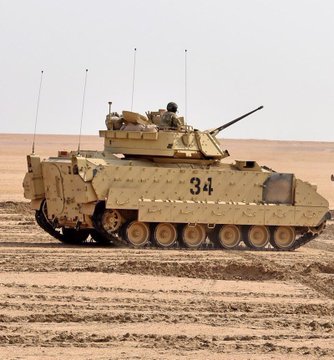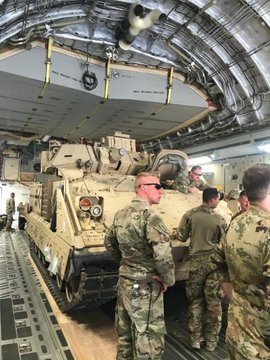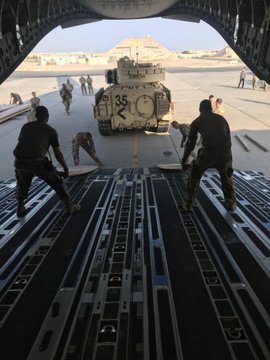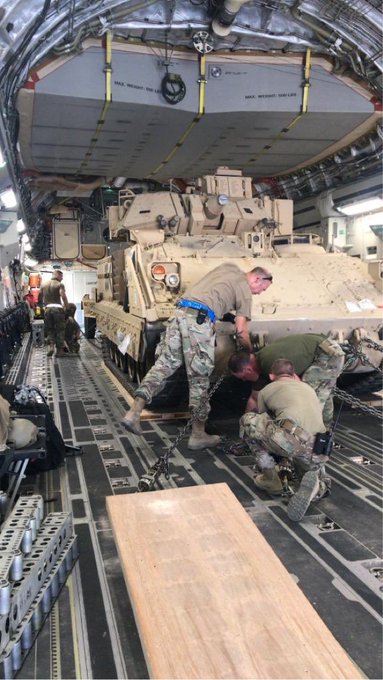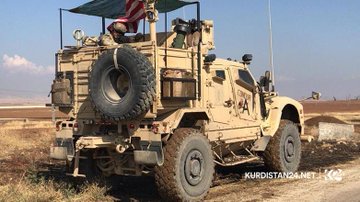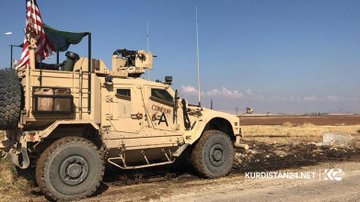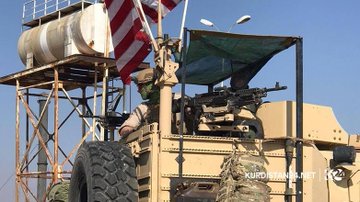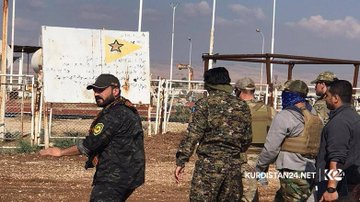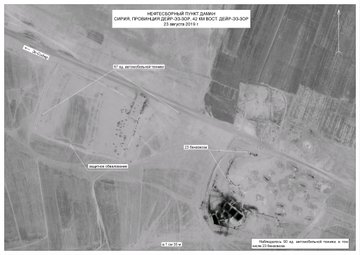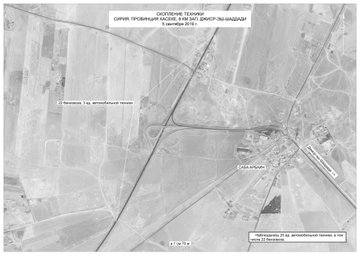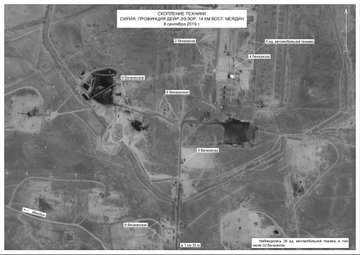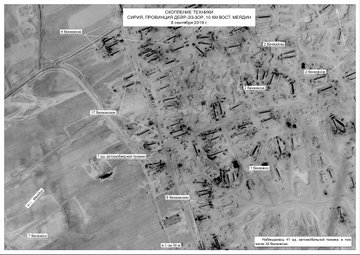The Russian military just dropped a geopolitical bomb, with satellite imagery supposedly showing the United States smuggling oil from Syria

finance.yahoo.com
USA stealing oil apparently.
 Army National Guard Bradley Fighting Vehicles Are Now In Syria Guarding Oil And Gas Fields
The mission, which is focused on keeping ISIS and Assad from getting these resources, is still rapidly evolving, but now includes heavy armor.
BY JOSEPH TREVITHICK
Army National Guard Bradley Fighting Vehicles Are Now In Syria Guarding Oil And Gas Fields
The mission, which is focused on keeping ISIS and Assad from getting these resources, is still rapidly evolving, but now includes heavy armor.
BY JOSEPH TREVITHICKOCTOBER 31, 2019
CJTF-OIR
SHARE
More than three weeks after the United States
announced it would be withdrawing the bulk of its forces from Syria, a contingent of U.S. Army National Guard M2A2 Bradley Fighting Vehicles and other troops have traveled aboard U.S. Air Force C-17 Globemaster III transport aircraft to a forward position in Deir Ez Zor in the eastern portion of that country. This also comes just days after the death of ISIS leader Abu Bakr Al Baghdadi during a
U.S. special operations raid in Syria. This new deployment appears to be the first wave of heavy armored forces headed to the area
as part of plan, aimed at ensuring that ISIS and the Syrian regime of Bashar Al Assad do not regain control of oil and gas fields in that province, which the Pentagon formally announced last week.
HERE'S EVERYTHING WE KNOW ABOUT THE REPORTED U.S. PLAN TO SEND TANKS TO SYRIA (UPDATED)By Joseph TrevithickPosted in
THE WAR ZONE
OUR ANALYSIS OF NEW INFO AND VIDEO FROM THE RAID THAT KILLED ISIS HEAD AL BAGHDADIBy Joseph Trevithick and Tyler RogowayPosted in
THE WAR ZONE
EVERYTHING WE KNOW AND DON'T KNOW ABOUT THE RAID THAT KILLED ISIS LEADER AL BAGHDADI (UPDATED)By Tyler Rogoway and Joseph TrevithickPosted in
THE WAR ZONE
SATELLITE PHOTOS CALL INTO QUESTION IMPACT OF U.S. BOMBING ITS OWN SYRIAN BASE AFTER RETREATBy Tyler Rogoway and Joseph TrevithickPosted in
THE WAR ZONE
U.S. AIRPOWER MAKES SHOW OF FORCE TO PROTECT TROOPS IN SYRIA AS SECURITY SITUATION UNRAVELSBy Joseph TrevithickPosted in
THE WAR ZONE
NBC News first reported the deployment early on Oct. 31, 2019. U.S. Army Colonel Myles Caggins, the top spokesperson for the U.S.-led coalition fighting ISIS in Iraq and Syria, Tweeted out three pictures of U.S. personnel loading a Bradley from the South Carolina Army National Guard's 4th Battalion, 118th Infantry onto a C-17 at an unspecified base in the Middle East later that day. The base in question appears to be Ali Al Salem Air Base in Kuwait based on hardened aircraft shelters and other features seen in the background.
Caggins also included a fourth picture showed one of the battalion's M2A2s on a training range in Kuwait earlier in the week. The social media post did say specifically that troops from 4-118th were headed to Deir Ez Zor.
390 people are talking about this
"What we want to do is ensure that ISIS is not able to regain possession of any of the oil fields that would allow them to gain income going forward," U.S. Marine Corps General Frank McKenzie, head of U.S. Central Command,
had told reporters regarding the overall plan
during a press conference on Oct. 30, 2019. "As of right now, we have secured the oil fields at Deir Ez Zor, generally east of the Euphrates River, in the vicinity of [the] Conoco [Gas Plant] and Green Village."
CRS
A map showing the general zones of influence in Syria as of March 2019. The situation in the country has shifted dramatically since then, with the blue and green areas expanding significantly in the northeast. The marker indicating the prense of U.S. forces in Deir Ez Zor is the general location of the existing American position near the Conoco Gas Plant and Green Village.
The
first batch of reinforcements for U.S. forces already in Deir Ez Zor, riding in a mix 4x4 mine-resistant
M-ATVs and other light vehicles, had crossed the border from Iraq into Syria this past weekend. Additional American personnel in M-ATVs moved into Syria from Iraq on Oct. 31, 2019, as well, but it is not clear if they are also headed further east.
119 people are talking about this
However, on Oct. 25, 2019, U.S. Secretary of Defense Mark Esper
had confirmedthat the final force posture in Deir Ez Zor would include "some mechanized forces," a term that typically refers to tanks or other heavy armored vehicles. Previous reports, citing unnamed sources, had said that
M1 Abrams tankswould also be among this particular group of troops.
4-118th is a
combined arms battalion equipped with both Bradleys and Abrams and had those vehicles with it when it deployed to Kuwait sometime earlier in the month. The battalion is part of the Army National Guard's 30th Armored Brigade Combat Team, the bulk of which is part of the North Carolina National Guard, but which also includes troops from the South Carolina and West Virginia Army National Guards. The 30th began arriving
in Kuwait last week to relieve the regular Army 3rd Brigade Combat Team, 4th Infantry Division.
US ARMY NATIONAL GUARD
An M2A2 Bradley, at left, and three M1 Abrams tanks belonging to 4th Battalion, 118th Infantry conduct routine training in Kuwait on Oct. 28, 2019.
The Army always has a forward-deployed armored brigade in that country as part of
Operation Spartan Shield. Forces deployed in support of this operation are on call to be able to respond to any potential contingency in the Middle East and the
War Zone had posited last week that whatever brigade was deployed to Kuwait was the most likely force provider for the new mission in Deir Ez Zor. Units from the various brigades that have rotated through this deployment over the years have already
taken part in operations in Syria.
It is not clear yet whether the battalion is also sending some of its tanks into Syria. The M2A2s, with their 25mm automatic cannons and TOW anti-tank missiles, are certainly better armed and armored than lighter vehicles, such as M-ATVs. They also have a more
robust suite of sensors that will help troops monitor the areas around their positions, especially at night.
However, the Bradleys would still not offer the same anti-armor capability as even a small group of M1s with their 120mm main guns, which could be important if the force finds itself facing off against a more conventionally armed opponent. In 2018, a force aligned with the Syrian regime of dictator Bashar Al Assad, with the
support of Russian mercenaries and equipped with tanks and heavy artillery, notably attempted to eject American forces and their local partners from a position near the Conoco Gas Plant in Deir Ez Zor. A
massive counterattack involving air and artillery strikes was necessary to repel that threat.
The full size and scope of force that will take up positions in Deir Ez Zor remains unclear, as well.
Previous estimates have ranged anywhere from 200 to 700 troops in total, which would be in addition to U.S. personnel who have been occupying the position near the Conoco Gas Plant since at least the beginning of 2018.
"We've got forces at Deir ez-Zor, that is – we have brought in some reinforcements there," General McKenzie had said on Oct. 30. "We'll await further decisions of the U.S. government about how that plan is going to look in the long term."
It's also important to note that this deployment very publicly shifts what had been a U.S. special operations forces-led mission in Syria to a more outwardly conventional military operation. Of course, conventional forces
had been supporting special operators for years in large numbers and had been assisting local forces in what was already
a largely conventional conflict.
The exact scope of the mission has been a matter of debate, as well. As McKenzie had said, the primary official goal was to prevent ISIS from retaking the area, which could be a potentially lucrative source of income for the terrorists. It has also been widely reported that
the Pentagon is eager to ensure that Assad and his regime in Damascus, as well as its Russian and Iranian allies, cannot take advantage of these resources, which had been a major source of income for Syria in the past, and otherwise
cannot reassert themselves in the eastern part the country.
With regards to ISIS, despite the recent loss of its leader in a U.S. special operations raid, and
its second in command, in an airstrike soon thereafter, there are concerns that this group may be regaining strength
amid the chaos in Syria that a Turkish intervention in the north that began earlier this month has unleashed. Turkey's operation has targeted the U.S.-backed predominantly Kurdish Syrian Democratic Forces (SDF), which have been instrumental in rolling back ISIS, and have drawn their attention away from that mission. It also precipitated
a hasty withdrawal of American forces from much of northeastern Syria. The Syrian regime of Bashar Al Assad, together with its Russian and Iranian allies, has also made territorial gains and could be looking to launch a new push to retake Deir Ez Zor.
US ARMY
US personnel load a mine-resistant vehicle into a C-17 at the Kobane Landing Zone in Syria on Oct. 24, 2019, as part of the withdrawal of American forces from northeastern Syria.
However, President Donald Trump, as well as members Congress, have also indicated that the United States may be looking to find some way to help reestablish more robust oil and gas extraction operations in Deir Ez Zor, which could involve American companies. "What I intend to do, perhaps, is make a deal with an Exxon Mobil or one of our great companies to go in there and do it properly," Trump had
said on Oct. 27, amid remarks regarding the operation that led to the death of Baghdadi.
"This is a win-win: The SDF will get more money if we can modernize the oil fields," Senator Lindsey Graham, a South Carolina Republican and major political ally of President Trumps, who
was initially critical of the U.S. withdrawal from Syria,
said on Oct. 29. "We're not going over there to enrich America – we're over there to help our allies, deny our enemy resources that will allow them to get stronger over time and finally – and this is O.K. – to lower the cost to us."
There are questions about whether this oil-and-gas-related mission
is even legal under existing U.S. and international laws. Russia has, unsurprisingly, already criticized the American plan as violating Syrian sovereignty.
138 people are talking about this
Reports, citing anonymous sources,
have also indicated that the U.S. military deliberately framed the issue around those resources in order to win President Trump's support for remaining Syria to combat ISIS and to prevent Assad and his allies from regaining control of the eastern part of the country. Trump had originally announced his
intention to fully withdraw American forces from the country in December 2018.
Experts also debate
just how lucrative the oil in Deir Ez Zor might be for anyone, given that production there has historically been low in both quantity and quality. Still, while it hasn't been a major factor in global oil markets, it had provided
up to 25 percent of the the Syrian regime's total annual revenues in the past and could be equally valuable for a small, non-state actor, such as ISIS. The SDF itself has been working with
Syrians tied to Assad in order to sell the oil anyway, for lack of other realistic options, though the U.S. government might be looking now at ways to cut out these middlemen for good.
As the
War Zone noted
in its initial reporting, questions also remain about just how viable a U.S. presence of any kind will be in Deir Ez Zor in the long term. These positions could be especially precarious if they become increasingly isolated as American forces withdraw from much of the rest of the country, ceding territory to other actors in the process. You can read more in detail about the complex logistical and force protection issues involved in our previous story
here.
Regardless, the U.S. force posture in Deir Ez Zor, at least for the time being, will now feature M2A2 Bradleys and could be home to other U.S. heavy armored forces soon.
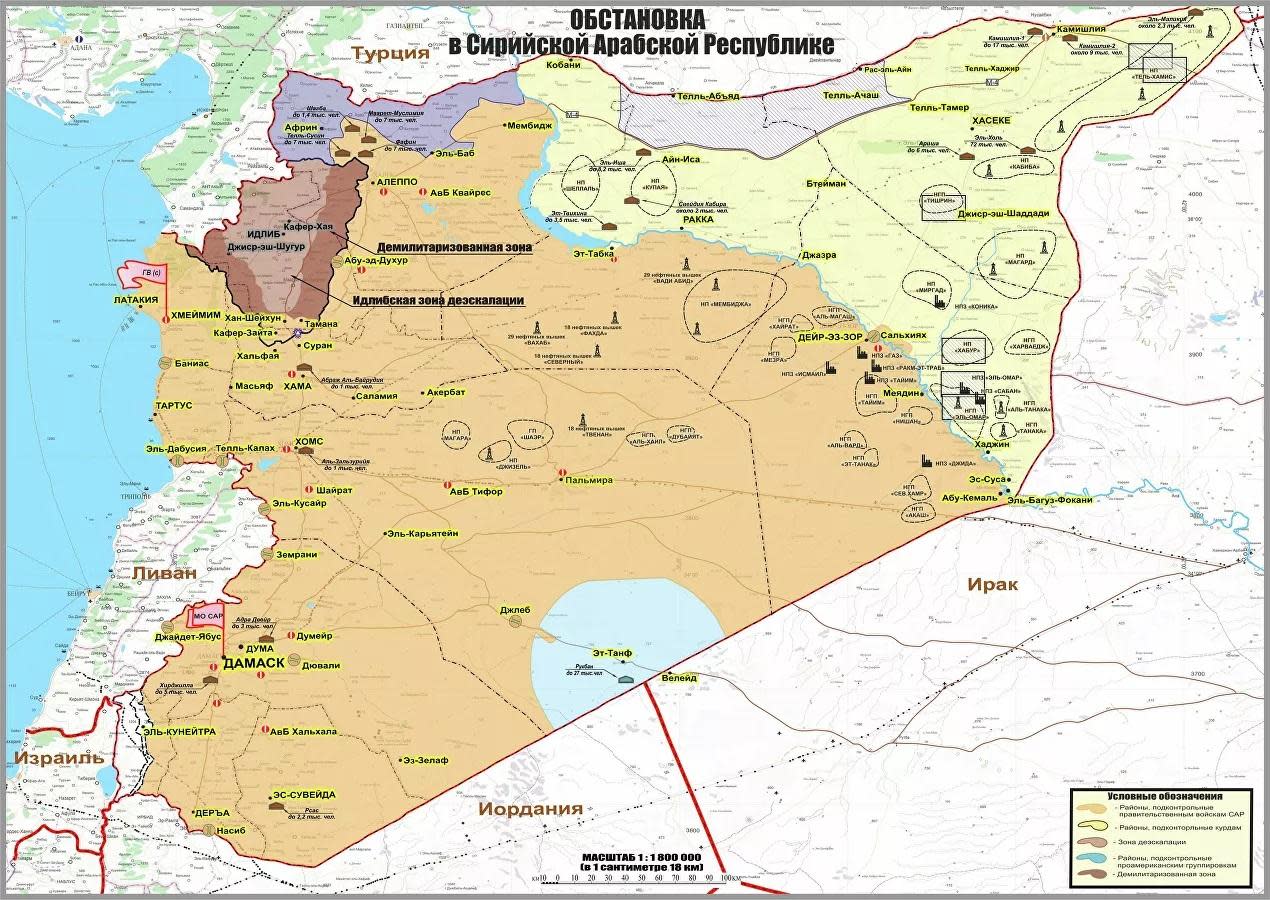
finance.yahoo.com
 Army National Guard Bradley Fighting Vehicles Are Now In Syria Guarding Oil And Gas Fields
Army National Guard Bradley Fighting Vehicles Are Now In Syria Guarding Oil And Gas Fields

